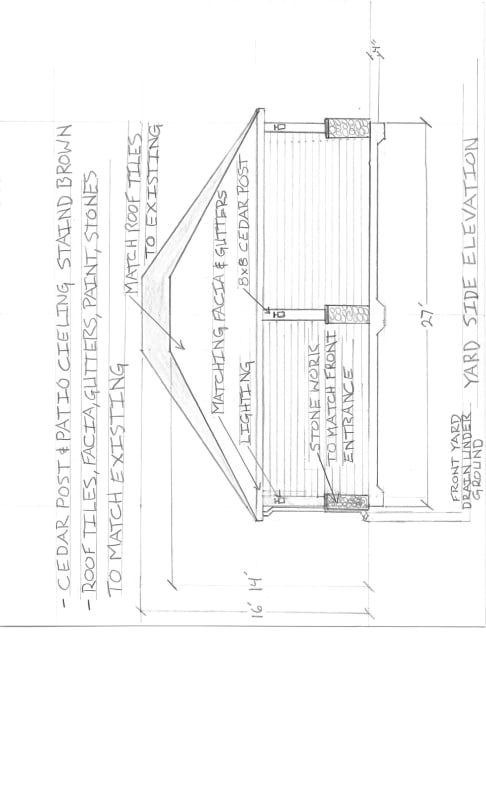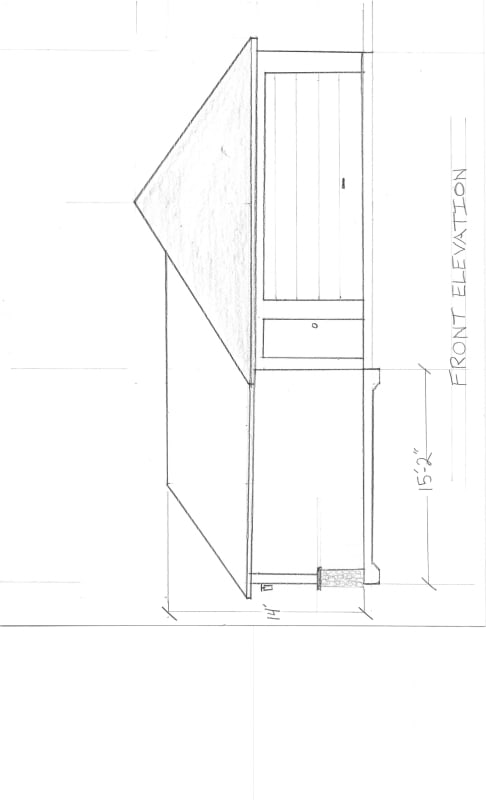First time poster long time DIY'er, fellow engineer (IT Networking) looking for help.
Looking for advice on a covered patio build. It will attach to the detached garage that has a hip roof on it. I will add a ridge and carry the backside of the roof pitch all the way out over the new patio addition (add another hip roof basically. The patio is 22 feet long and will have (3) 8x8 cedar post. The post are 15 feet off the garage wall and about 11 ft apart. I am trying to determine the size of the beams I need. I will likely use multiple ply of 2x12 like a 4plyx2x12 for all my beams but I want know what if that is to much. I really want to get down to 2ply 2x10 cedar IF possible.
I have three 15 foot spans (post to garage). On Garage side I will sit on trimmer/jack studs under the garage sill plate. I am not planning on using a ledger board. What size beam for this?
Then I have the 22 foot span with a post in the middle. So I guess 2x 11ft spans. Again I was thinking 4plyx2x12 but want to use 2ply2x10 cedar again . Whats the recommended size beam here?
There will be a ridge 2x6 with 2x6 rafters and a composite shingle roof. I will also run some 2x6 joist for a cedar t&g ceiling between the beams. 12/8 pitch on the roof and I am in Texas where we do not get snow but have gotten some hurricane winds in the past.
I would love for the beams to be 2x10 instead of 2x12 if possible because it allows me to use cedar planks readily available at my Home Depot. Is this possible? Attached are some pictures to give an idea but the roof is drawn wrong. The new ridge will be as high as the existing and the back existing roof will be the same all the way across with no valley. Only one side will have a valley.
I'm sure you guys get these kinds of questions all the time, Im sorry but really appreciate any input.


Looking for advice on a covered patio build. It will attach to the detached garage that has a hip roof on it. I will add a ridge and carry the backside of the roof pitch all the way out over the new patio addition (add another hip roof basically. The patio is 22 feet long and will have (3) 8x8 cedar post. The post are 15 feet off the garage wall and about 11 ft apart. I am trying to determine the size of the beams I need. I will likely use multiple ply of 2x12 like a 4plyx2x12 for all my beams but I want know what if that is to much. I really want to get down to 2ply 2x10 cedar IF possible.
I have three 15 foot spans (post to garage). On Garage side I will sit on trimmer/jack studs under the garage sill plate. I am not planning on using a ledger board. What size beam for this?
Then I have the 22 foot span with a post in the middle. So I guess 2x 11ft spans. Again I was thinking 4plyx2x12 but want to use 2ply2x10 cedar again . Whats the recommended size beam here?
There will be a ridge 2x6 with 2x6 rafters and a composite shingle roof. I will also run some 2x6 joist for a cedar t&g ceiling between the beams. 12/8 pitch on the roof and I am in Texas where we do not get snow but have gotten some hurricane winds in the past.
I would love for the beams to be 2x10 instead of 2x12 if possible because it allows me to use cedar planks readily available at my Home Depot. Is this possible? Attached are some pictures to give an idea but the roof is drawn wrong. The new ridge will be as high as the existing and the back existing roof will be the same all the way across with no valley. Only one side will have a valley.
I'm sure you guys get these kinds of questions all the time, Im sorry but really appreciate any input.


